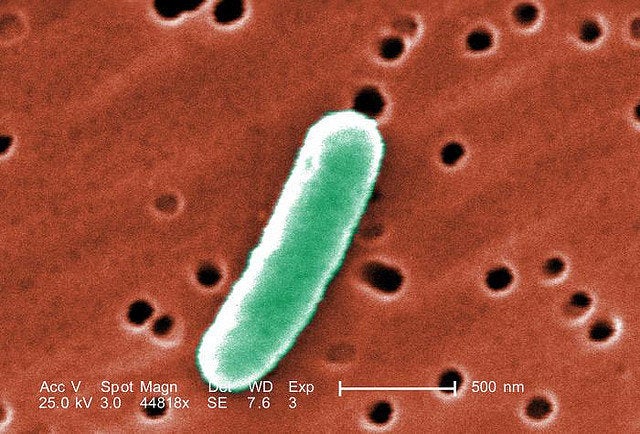
An August 25, 2012 Washington Post article talked about a superbug outbreak at the NIH. The article highlighted the problem that we are running out of useful antibiotics. Antibiotic resistance is an evolutionary question of great practical importance. I have recently been asked and agreed to sign on to petitions requesting that antibiotic use in animals be banned for the sake of human health.
There is no evolutionary phenomenon we understand better than multiple antibiotic resistance in bacteria. It has been occurring virtually synchronously with the development of molecular genetics for 60 years. For public health as well as scientific reasons, antibiotic resistance was a major focus of the first decades of molecular biology.
Let us use this well-studied phenomenon to disentangle some of the thorny questions raised and debated in my most recent two blogs dealing with evolutionary processes (you can read them here and here). Our knowledge of the underlying cell and molecular biology makes it possible to discuss these questions in terms of specific experimental results rather than abstract principles.
The chief factor in the rapid evolution of multiple antibiotic resistance is the presence of sequences encoding resistance mechanisms on transmissible plasmids (Watanabe 1967). It was my PhD supervisor, Bill Hayes, who first demonstrated the existence of transmissible plasmids. They have proved to be extremely important evolutionary tools in bacteria.
Working under minimalist conditions (Bill initially had to make his own petri dishes by cutting the bottoms off glass vials), he demonstrated that sexual recombination in E. coli required an infectious factor that he called F, for fertility (Hayes 1968). Bill demonstrated that F was independent of the E. coli chromosome by studying the kinetics of its spread in a bacterial population. He found that F could replicate and spread though the population far faster than the 30 minute division time of the bacteria. This kind of autonomously replicating element came to be called a plasmid (Novick 1980).
A graph showing the spread of an antibiotic resistance plasmid in the absence of antibiotic is included in Watanabe's Scientific American article on transmissible antibiotic (Watanabe 1967). This result is significant because it shows how the mobility apparatus of the plasmid can operate to distribute the plasmid and make it spread through an unselected population of bacteria. Later, when antibiotic is applied, a large fraction of the population is already resistant.
In my recent blogs, a number of commentators asserted that the source of variation is immaterial to evolution because natural selection works on any variants that appear. But, as I pointed out in the first blog on superbugs, cells which can only modifying their existing genomes cannot achieve the same high levels of antibiotic resistance as cells that can pick up DNA from outside. Moreover, they are certainly not able to establish a resistant population prior to encountering selection as quickly as cells that have received a resistance plasmid.
Acquiring DNA from other cells, "horizontal transfer," occurs among bacteria most commonly by plasmids. However, bacterial cells can also take DNA up directly from the environment or receive it by viral infection. All these processes have been amply documented to occur in nature.
The F plasmid that Bill Hayes identified did not carry any antibiotic resistance sequences. So it is important to ask how those particular sequences came to be associated with transmissible plasmids. The answer leads us to two intriguing natural genetic engineering systems, transposons and integrons.
Transposons are segments of DNA that have the capacity to move (or "transpose") from one location in a genome to another (Cohen and Shapiro 1980). In order to make an antibiotic resistance sequence itself part of a transposon, it is sufficient to surround it by two copies of an existing transposon. This sometimes occurs normally as part of the transposition process, but other classes of transposons have been found already associated with antibiotic resistance sequences incorporated inside.
Once an antibiotic resistance determinant has the capacity to transpose, it is easy to see that it can insert into a plasmid and become transmissible to other cells. This is clearly the source of many resistance plasmids. The resistance determinants can be observed moving between plasmids (Hedges and Jacob 1974) and from plasmids to other components of the bacterial genome, such as the chromosome or viral DNA (Bukhari 1977).
In a fascinating example of genetic specialization, the structures known as "integrons" have been found to exist inside plasmids, transposons, and even bacterial chromosomes. Identified initially by Ruth Hall and her colleagues in the 1990s (Hall and Stokes 1993), integrons are DNA platforms for accumulating cassettes containing the sequences encoding proteins for antibiotic resistance, bacterial virulence, and other properties. These cassettes can accumulate and build up a number of multi-resistance DNA sequences.
Faced with such a powerful bacterial toolbox for accumulating and spreading antibiotic resistance, it is no wonder that we have been caught off guard underestimating the capacity of these small cells to evolve high levels of resistance quickly. Many questions remain to be clarified, such as where the resistance sequences themselves arose, but the DNA manipulation virtuosity of the bacteria should give us pause in thinking we have yet plumbed the depths of the evolutionary process.
REFERENCES
Bukhari, A. I., J.A. Shapiro, and S. L. Adhya (Eds.) (1977). DNA insertion elements, plasmids and episomes Cold Spring Harbor, New York, Cold Spring Harbor Press.
Cohen, S. N. and J. A. Shapiro (1980). "Transposable genetic elements." Sci Am 242(2): 40-49. http://www.ncbi.nlm.nih.gov/pubmed/6246575.
Hall, R. M. and H. W. Stokes (1993). "Integrons: novel DNA elements which capture genes by site-specific recombination." Genetica 90(2-3): 115-132. http://www.ncbi.nlm.nih.gov/pubmed/8119588.
Hayes, W. (1968). The Genetics of Bacteria and their Viruses (2nd ed.). London, Blackwell.
Hedges, R. W. and A. E. Jacob (1974). "Transposition of ampicillin resistance from RP4 to other replicons." Mol Gen Genet 132(1): 31-40. http://www.ncbi.nlm.nih.gov/pubmed/4609125.
Novick, R. P. (1980). "Plasmids." Sci Am 243(6): 102-104, 106, 110 passim. http://www.ncbi.nlm.nih.gov/pubmed/6259723.
Watanabe, T. (1967). "Infectious drug resistance." Sci Am 217(6): 19-28. http://www.ncbi.nlm.nih.gov/pubmed/6061177.